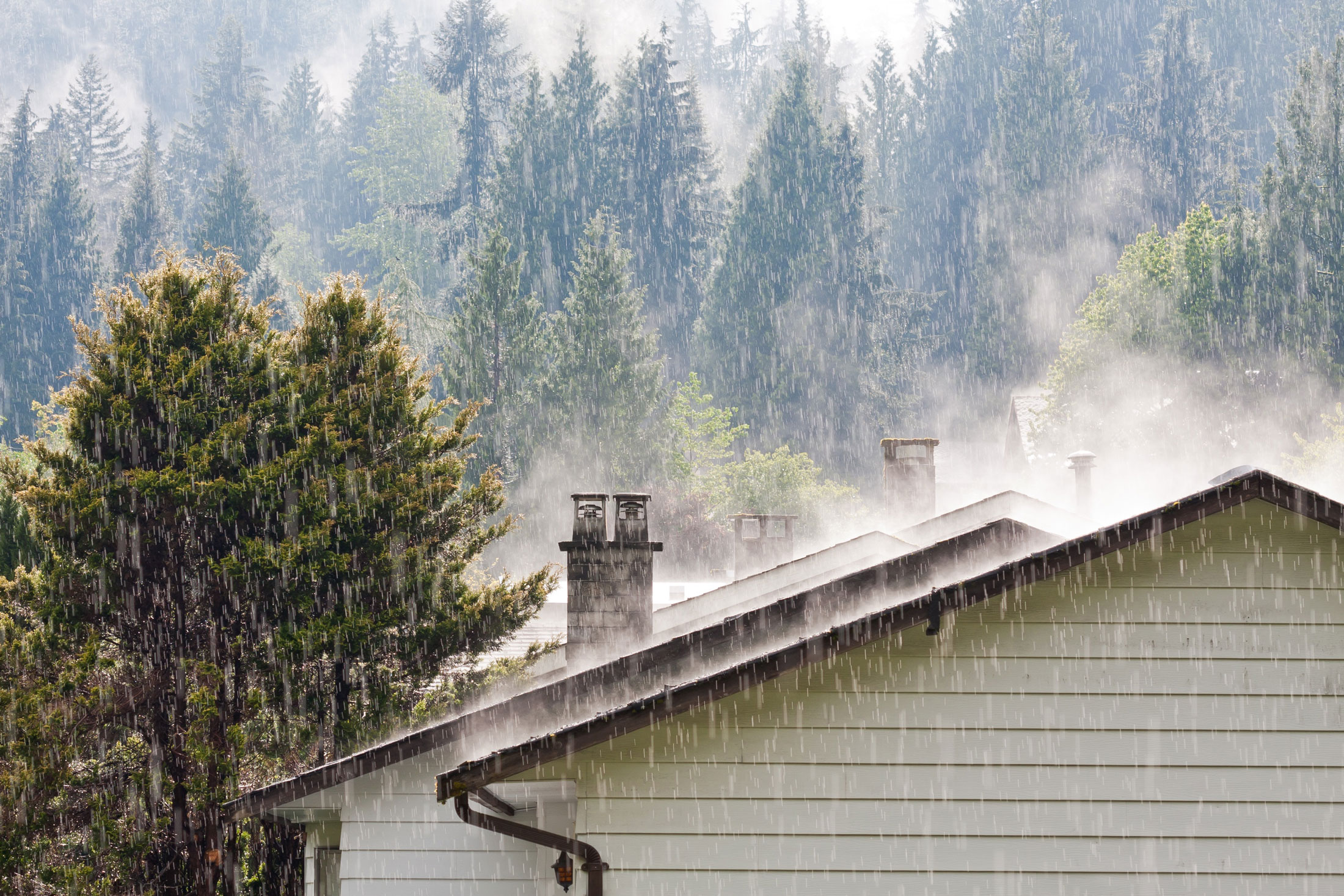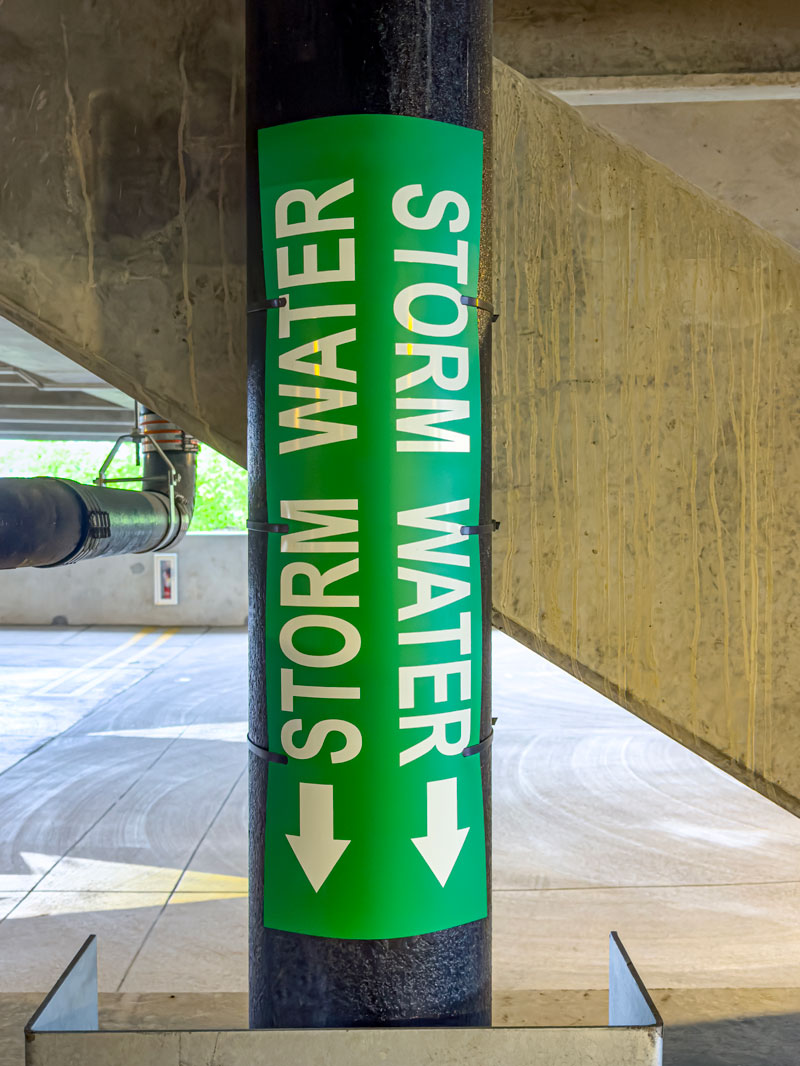
SMARTER STORMWATER MANAGEMENT AND FLOOD MITIGATION FOR A CHANGING CLIMATE
The increasingly intense storms striking the Southeast have underscored the urgent need for smarter stormwater management and flooding mitigation strategies. Flooding devastates homes, overwhelms infrastructure, and compromises public health. By designing resilient systems that manage stormwater more effectively, communities can better protect people and property while reducing long-term costs.
As areas are redeveloped and the landscape changes, such impervious surfaces as pavement and roofs that prevent precipitation from naturally soaking into the ground become more prevalent. Stormwater solutions address this challenge by managing the entire lifecycle of a raindrop, and, when possible, repurposing runoff so it can provide community benefits while reducing the risks of flooding and other negative impacts.
Ideally, stormwater is absorbed into the soil, where it is filtered and replenishes aquifers, or flows into streams and rivers. However, in cases when heavy rainwater saturates the ground, excess moisture runs across the surface and into storm sewers and road ditches. This water often carries debris, chemicals, bacteria, eroded soil, and other pollutants, and introduces them into streams, rivers, lakes, or wetlands, and causes flooding in extreme cases.

Stormwater pipe installed within a concrete parking garage, structure. | GETTY IMAGES
Best Practices for Mitigation
IAPMO Vice President of Technical Services and Research Christoph Lohr, PE, said of all the factors that determine a building’s resiliency, properly sized storm drains are the most important.
Definitions on the difference between stormwater and rainwater can vary, but rainwater is generally accepted as natural precipitation that has not been contaminated by use. IAPMO’s Water Efficiency and Sanitation Standard (WE•Stand®), the first American National Standard focused entirely on efficient water use in buildings while maintaining safety, defines stormwater as “Natural precipitation that lands on a man-made, above-ground surface and can be collected on site for beneficial uses.”
In 2024, IAPMO and the American Society of Plumbing Engineers (ASPE) co-published White Paper 2-2024: Capacities of Stacks and Horizontal Drains in Storm Drainage Systems.
The sizing for storm drainage systems is dependent upon flow capacity equations used to calculate velocities and flow rates in pipe conduits. One of the variables in the equations is the coefficient of roughness. The white paper explores how the roughness of different types of material will change the computational results that are dependent upon the roughness coefficient of the pipe.
With some model codes used in the Southeast mismatching pipe material with their sizing tables, the potential for roof collapse or pipe-bursting inside the building increase. It is vital for cities and states to take a second look.
“Storm drainage systems play a vital role in building resiliency as they convey water off the roof”, said Lohr, who co-authored the white paper. “Studying storm piping systems is important to make sure these systems are not undersized, as the weight of water on a roof could exceed design parameters and fail, which could be catastrophic. With changing weather patterns, particularly rainfall rates increasing in many locations, revisiting assumptions and validating the equations of how storm piping systems are sized is vital. We are thankful to our partners at ASPE for collaborating with us on this white paper, which shows the depth of plumbing expertise exhibited by both organizations and their dedication to public safety.”
Daniel Figola, director of National Engineering for Advanced Drainage Systems, Inc., and a member of ARCSA International’s Board of Directors, said the best practices for stormwater mitigation are changing and adapting. The U.S. Environmental Protection Agency (EPA) requires certain types of waste or runoff to be detained on site before being released to prevent pollution and erosion, which changed the practice of moving that water offsite as quickly as possible.
With climate change driving both heavier rain events and longer lasting droughts, Figola explained that many conveyance pipes and detention systems are undersized for today’s rainfall patterns. Infiltration solutions, such as permeable pavements and rain gardens, are effective for managing runoff, but they are not designed to address large-scale flood control.
“When you’re getting these unanticipated rainfall events you almost need a belt-and-suspenders approach in my opinion, where you need to have all of those components,” he said. “You need to properly size the pipes carrying the water, you need to properly size your detention systems and ideally should be reusing that water or infiltrating a component of it to reduce that downstream runoff and recharge groundwater tables.”

GRAPHIC COURTESY OF ADVANCED DRAINAGE SYSTEMS, INC.
David Dexter, PE, an engineer and master plumber who chaired IAPMO’s stormwater pipe sizing task group, said regulations prohibit property owners from discharging more off the site than would occur if the site were in its natural condition, which presents a problem given the present landscape.
“We have made hard surfaces all over the place so the water had nowhere to go and we wind up having floods,” he said. “You have to find some means to get that water to go into the ground or retain it where it can eventually evaporate or leach into the ground over a period of time as compared to allowing it to escape your property.”
A rain garden is a shallow, landscaped basin that collects rainwater from rooftops, driveways, and streets, allowing it to soak naturally into the ground. Planted with native grasses and vibrant perennials, rain gardens not only reduce runoff in a cost-effective way but also enhance the landscape’s beauty. Beyond stormwater management, they improve water quality by filtering pollutants and provide valuable habitat for songbirds, butterflies, and other wildlife.
ARCSA/ASPE/ANSI 78-2023: Stormwater Harvesting System Design for Direct End-Use Applications, covers on-site, single-property stormwater catchment systems that utilize the principle of collecting and using precipitation or stormwater from rooftop and other impervious surfaces at, below and above grade.
The standard addresses direct or active applications such as directing stormwater into a cistern as well as indirect or passive applications, also known as low-impact development (LID) or green infrastructure. ARCSA is updating the standard, and Figola chairs the committee.
ARCSA International Executive Director Heather Kinkade said it is important to design infiltration systems that steadily disperse the water rather than directing it all to the same place.
“Catching and infiltrating the stormwater in smaller quantities helps to reduce peak flow rates and keeps the land from being overwhelmed. Soils can typically handle/process small quantities of pollutants,” she said, “where the typical design is just to flush all the stormwater to a big basin, intensifying flow rates and pollutants.”
The National Institute of Building Sciences is an independent, nonprofit organization dedicated to advancing building science and technology. The group developed the Whole Building Design Guide (WBDG), which is a resource that offers guidance on integrating building systems and technologies to create high-performance, sustainable, and resilient buildings.
The WBDG Includes a Section on LID, Examples of Which Include:
- Engineered systems that filter stormwater from parking lots and impervious surfaces, such as bioretention cells, filter strips, and tree box filters;
- Engineered systems that retain (or store) stormwater and slowly infiltrate water, such as sub-surface collection facilities under parking lots, bioretention cells, and infiltration trenches;
- Modifications to infrastructure to decrease the amount of impervious surfaces such as curbless, gutterless, and reduced-width streets.
- Low-tech vegetated areas that filter, direct, and retain storm water such as rain gardens and bio-swales;
- Innovative materials that help break up (disconnect) impervious surfaces or are made of recycled material such as porous concrete, permeable pavers, or site furnishings made of recycled waste;
- Water collection systems such as subsurface collection facilities, cisterns, or rain barrels; and
- Native or site-appropriate vegetation. If the goal is to retain and reuse the water at some point, cisterns or reservoirs are the better option.
Save It for Later
Underground cisterns and reservoirs can significantly enhance stormwater management, reducing runoff volume and maximizing the use of space. Surface-level ponds and the like require valuable real estate, whereas subsurface cisterns, reservoirs or other storage means can be put under such areas as parking lots that were going to be developed anyway, leaving that additional area untouched and available for another purpose.
“The real benefit of the underground cisterns is the capture of the water before it leaves the site to either slow it down or keep it from leaving the site at all through reuse practices,” Figola said. Proper pipe sizing in these systems is vital, he said, pointing out that while most storm sewers are designed for a 10-year rainfall event on a private site, storms of significantly higher intensities than what they were designed for are becoming increasingly more common, leading to overland flooding and road overtopping.
“You need to make sure you’ve properly sized for the volume of water that you’re anticipating so that it gets where it needs to go and doesn’t end up running off and flooding elsewhere,” he said.
Additionally, Figola said, large surface ponds can lose appreciable amounts of water through evaporation, which is particularly important in areas where water is scarce and every gallon counts, and that is not as big of an issue when the water is stored underground.
Backflow Prevention
Sean Cleary, IAPMO vice president of Industry Programs and Backflow Prevention Institute (BPI) Operations, said sizing of piping and water storage is a challenging task with many variables to consider. It must be based on numerous factors including normal rainfall, extreme weather conditions, drought, the intended usage of the system, peak demands on the system and possible other emergency water sources to make up for a lack of rain, snow or other normal resources used to supply the system.
In many cases, when system demand exceeds the available resources, potable water from the public water supply is used to make up for the necessary supply. Any connection between these systems either directly or indirectly is a cross-connection that requires backflow protection.
“Because of the unknown quality of the storm or rainwater system, this connection must be considered a high hazard situation that requires in most cases an airgap to separate the potable and non-potable water systems,” he said. “If a direct connection is allowed, the protection would need to be provided by the installation of a reduced pressure principle assembly.
Need for Trained Professionals
Trained design professionals — such as architects, civil and mechanical engineers, landscape architects and plumbers — are essential for effective and comprehensive stormwater management and flood mitigation plans. Without proper expertise, both soft and hardscape systems may be incorrectly sized, leading to dangerous consequences. Professionals must understand the calculations behind storm drainage design, ensuring systems can handle extreme rainfall events. Proper training helps reduce the risk of pipe bursts, roof collapses, and overwhelmed landscapes by ensuring stormwater systems are correctly installed and maintained.
“If they don’t know the math behind it, they may put in the wrong size system without even knowing it because they’re basing the decision making on faulty data,” Lohr said. “Having that additional training, having that additional expertise is definitely helpful in minimizing that risk of a potential roof collapse or pipe bursting.”
Policy-Driven Resilience
Policymakers play a crucial role in supporting plumbers and builders by developing and enforcing effective codes and standards for stormwater management and flood mitigation. By implementing regulations based on sound engineering principles, they help ensure that plumbing professionals have clear guidelines for designing and installing resilient systems.
Additionally, policymakers can provide funding for training programs, promote the adoption of advanced technologies, and encourage the use of sustainable infrastructure solutions. Their support is essential for creating safer communities by reducing the risks of system failures, property damage, and public safety hazards during extreme weather events. IAPMO Senior Director of Government Relations Jim Scarborough emphasized the importance of stronger infrastructure and federal assistance in rebuilding efforts.
“If you want buildings and infrastructure to survive what they call once-in-a-century storms that seem to be happening every year now, then you’ve got to build them stronger,” he said. “It’s hard to prepare for something when you’re moving more than 40 feet of earth to take out underground pipes. That’s just something you hardly ever experience; that’s catastrophic. And I think in those cases, you’re going to have to have federal dollars. The states are not going to be able to put up the kind of funding to recover from that by themselves.
“As people become aware, as they see these weather events happening with such frequency, that may say more to legislators than anything.”
As climate change drives more frequent and severe storms, the need for smarter storm-water solutions has never been greater. Well-designed, well-maintained systems, featuring best practices such as right-sized piping, green infrastructure, and water reuse, can increase resiliency while lowering long-term costs. Lasting success depends on collaboration among plumbing professionals, engineers, policymakers, and builders to ensure these systems remain both effective and sustainable.
Investing in innovative solutions and a skilled workforce strengthens infrastructure, protects property, and helps communities adapt with confidence to future challenges.
This article originally appeared in Southern PHC magazine and serves as the second installment in a series examining the rebuilding of plumbing systems in the Southeastern United States.

Mike Flenniken is a staff writer, Marketing and Communications, for IAPMO. Prior to joining IAPMO in 2010, Flenniken worked in public relations for a group of Southern California hospitals and as a journalist in writing and editing capacities for various Southern California daily newspapers.
Last modified: November 3, 2025
